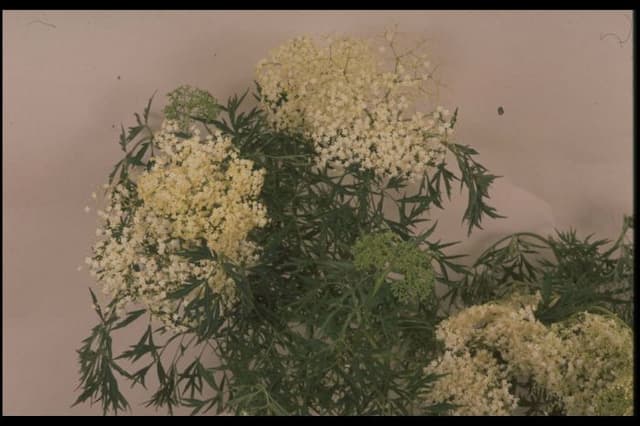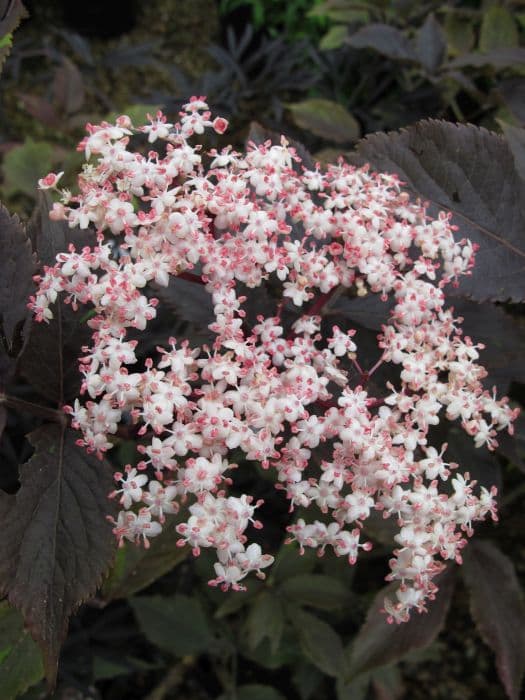Willowwood Viburnum Viburnum × rhytidophylloides 'Willowwood'

ABOUT
The Willowwood is a hybrid viburnum that combines attractive foliage and blooms. Its leaves are textured with deep grooves, presenting a leathery appearance that adds visual interest. They maintain a lush green hue and can have a wrinkled surface which provides a distinctive, tactile appeal. When this plant flowers, it produces clusters of small, creamy white blossoms that come together in a rounded shape, known as cymes, which exude a light fragrance. These flower clusters provide a striking contrast against the dark green of the leaves. As the season progresses, the flowers give way to fruit, which start green and ripen to a glossy, attractive black. These berry-like fruits can attract birds and other wildlife to the garden.
About this plant
 Names
NamesSynonyms
Willowwood Viburnum, Leatherleaf Viburnum Hybrid
Common names
Viburnum × rhytidophylloides 'Willowwood'.
 Toxicity
ToxicityTo humans
The Willowwood viburnum is not generally considered to be poisonous to humans. However, most viburnums contain substances that can cause mild stomach upset if ingested in large quantities. Symptoms of ingesting parts of the plant might include nausea, vomiting, and diarrhea, though such cases are relatively rare and typically result from significant consumption.
To pets
The Willowwood viburnum is generally considered to have a low level of toxicity to pets. If pets consume parts of this plant, they could potentially experience mild gastrointestinal upset, which might manifest as vomiting or diarrhea. However, severe poisoning is unlikely unless large amounts of the plant are ingested.
 Characteristics
CharacteristicsLife cycle
Perennials
Foliage type
Semi-deciduous
Color of leaves
Green
Flower color
White
Height
8-10 feet (2.4-3 meters)
Spread
8-10 feet (2.4-3 meters)
Plant type
Shrub
Hardiness zones
5-8
Native area
Cultivar
Benefits
 General Benefits
General Benefits- Aesthetic Appeal: Adds visual interest to the garden with its lush green foliage and clusters of creamy white flowers.
- Wildlife Attraction: The flowers can attract pollinators such as bees, while birds are drawn to the berries.
- Landscape Versatility: Can be used for hedges, screens, or as a specimen plant in landscape design.
- Seasonal Interest: Offers year-round interest with flowers in spring, berries in late summer to autumn, and evergreen leaves.
- Durability: Tolerant of a wide range of soil types and conditions once established.
- Low Maintenance: Requires minimal care once established, suitable for gardeners of all skill levels.
 Medical Properties
Medical PropertiesThis plant is not used for medical purposes.
 Air-purifying Qualities
Air-purifying QualitiesThis plant is not specifically known for air purifying qualities.
 Other Uses
Other Uses- Viburnum × rhytidophylloides 'Willowwood' can be used to create a natural privacy screen due to its dense foliage, which grows well in hedges and provides privacy throughout the year.
- The branches of the Willowwood can be used in floral arrangements, especially during the winter when the plant's berries add a splash of color to indoor decorations.
- Its leaves can be used in crafts, such as leaf printing or rubbings, for educational purposes or to create natural patterns on fabric and paper.
- The plant can be used as a windbreak in landscapes prone to strong winds, helping protect more delicate plants and reduce soil erosion.
- Willowwood can be integrated into a wildlife garden to provide shelter and nesting sites for birds, as its dense growth offers protection from predators.
- The dried berries of the Willowwood can be included in potpourri mixes to add visual appeal and texture.
- Gardeners may use the plant as part of a sensory garden, where the varied textures of its leaves and the soft rustle they make in the wind contribute to the experience.
- The robust structure of the Willowwood makes it suitable for use in garden topiary, where it can be trimmed into various shapes and forms.
- Its wood can be used for small woodworking projects or as decorative twigs in rustic crafts and home decor.
- Willowwood's dense growth habit makes it suitable for use in permaculture designs as part of a guild or polyculture planting to support biodiversity.
Interesting Facts
 Feng Shui
Feng ShuiThe Viburnum is not used in Feng Shui practice.
 Zodiac Sign Compitability
Zodiac Sign CompitabilityThe Viburnum is not used in astrology practice.
 Plant Symbolism
Plant Symbolism- Renewal: The continual growth and rejuvenation of the plant's foliage symbolize new beginnings and fresh starts, mirroring the endless cycle of renewal in life.
- Protection: With its dense, evergreen leaves, 'Willowwood' can represent safety and shelter, offering protection from external harm or negative influences.
- Persistence: Its hardy nature and ability to thrive in various conditions convey the importance of perseverance and resilience in the face of challenges.
- Connection: The intertwining branches and comprehensive coverage of 'Willowwood' symbolize interconnectedness, reminding us of the importance of community and relationships.
 Water
WaterThe Leatherleaf Viburnum should be watered deeply and thoroughly, ensuring the root zone is moistened, which can be achieved with approximately 1 to 2 gallons of water for a newly planted shrub, depending on the plant size and soil conditions. It's important to water the plant once a week during its first growing season to establish a deep, extensive root system. During the second growing season, reduce watering frequency to every other week, unless there are periods of extreme heat or drought. Mature plants will require less frequent watering, relying on rainfall with supplemental water only during prolonged dry spells.
 Light
LightLeatherleaf Viburnum thrives best in full sun to partial shade, with at least 4 to 6 hours of direct sunlight each day. An ideal spot would be one where the morning sun encourages the drying of dew on leaves, thus reducing the risk of diseases, while providing some afternoon shade in areas with hot summers to prevent leaf scorch.
 Temperature
TemperatureLeatherleaf Viburnum is hardy and can tolerate a broad range of temperatures, thriving in zones 5 to 8. The plant can survive minimum temperatures down to -20°F and is comfortable in the maximum summer temperatures of up to 100°F, with ideal growth temperatures ranging between 60°F and 80°F.
 Pruning
PruningPrune Leatherleaf Viburnum to maintain shape and size, promote healthy growth, and remove dead or diseased wood. The best time for pruning is immediately after flowering in late spring or early summer, as this shrub flowers on old growth. Pruning should be done annually or as necessary to remove any crossed branches and to maintain the desired shape.
 Cleaning
CleaningAs needed
 Soil
SoilWillowwood Viburnum thrives in well-drained, fertile soil that's rich in organic matter. A soil mix of loam, peat, and sand in equal parts is ideal, maintaining a slightly acidic to neutral pH between 5.5 and 7.0.
 Repotting
RepottingWillowwood Viburnum is typically planted in-ground and does not require frequent repotting. If grown in a container, repot every 2-3 years to refresh the soil and accommodate root growth.
 Humidity & Misting
Humidity & MistingWillowwood Viburnum prefers average humidity levels but is adaptable to various conditions. It does not have specific humidity requirements but generally thrives in outdoor environments with natural humidity.
 Suitable locations
Suitable locationsIndoor
Ensure bright indirect light, moderate water, and good air circulation.
Outdoor
Plant in well-draining soil, full sun to partial shade, water regularly.
Hardiness zone
5-8 USDA
 Life cycle
Life cycleThe common name for Viburnum × rhytidophylloides 'Willowwood' is Willowwood Viburnum. Its life cycle begins with germination from seed, although it is often propagated by cuttings for uniformity. After rooting, the young sapling grows by developing a strong root system and foliage until it reaches the juvenile stage. As it matures, the plant enters a growth phase characterized by the development of its defining features: large, leathery leaves and clusters of white flowers that typically bloom in spring. Following pollination, the flowers produce berry-like drupes that transition from red to black when ripe, which can be dispersed by birds, leading to new plants if conditions are favorable. Eventually, the Willowwood Viburnum reaches maturity, completing its cycle and may continue to reproduce annually for many years, with proper care and favorable conditions.
 Propogation
PropogationPropogation time
Spring-Early Summer
The most popular method of propagation for the Willowwood viburnum is through semi-hardwood cuttings. This technique is typically done in late summer. To propagate, select a healthy, non-flowering stem that has started to mature but is not yet fully woody. Cut a section of the stem about 4-6 inches (10-15 cm) long, making sure the cutting has at least two sets of leaves. Remove the leaves from the lower half of the cutting to prevent decay and excess moisture loss. Dip the cut end into a rooting hormone to encourage root development. Plant the cutting in a pot filled with a mixture of peat and perlite, making sure at least one set of leaves is above the surface. Water the cutting and then cover the pot with a plastic bag to maintain high humidity around it. Place the pot in a bright area without direct sunlight until roots develop, which usually takes several weeks. Once rooted, the cuttings can be transferred to individual pots and eventually planted outdoors when they are strong enough to survive the elements.









